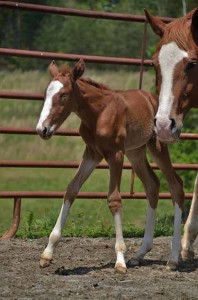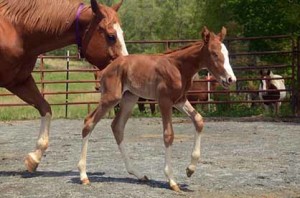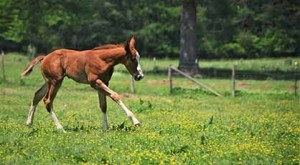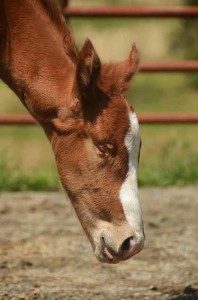I Don’t Think He Has Eyes
Blog By: Lydia Weaver
“The foal’s here.” The call came only as a mild surprise. I’d been at the barn several times the previous night to check on our mare, who was due to foal and slightly waxed up. The 3 am check showed the same as the previous two visits, a mare contentedly munching hay, showing no signs of labor or impending delivery, so I called off the 5 am check and went to bed. Later that morning, my daughter, Brenna, made a final check as she started morning feed chores.
The relief from that sentence was immediate, but that relief was obliterated by a sudden, sharp silence and the angst-inducing words to follow: “You need to get up here. We’ve got a problem.”
It doesn’t matter how sleep-deprived you are, hearing the words “foal” and “problem” in such close proximity, liberally sprinkled with a clear sense of urgency, inspires any mare owner on the face of the earth to find a new, much higher gear. I took off, still sporting my flannel jammies and hot-footed it to the barn, where Brenna declared, “He’s here, and he’s up.” Then, in the next breath, she delivered the verbal bombshell, “I don’t think he has eyes.”
Thus began the adventure of Spyn, our foal who was born with no eyes, a condition known as anophthalmia.
A funny thing about adventures, though, is that they often come to you cleverly disguised as catastrophe. It’s only after you have time to peel back the layers of surprise, disappointment, and even fear and grief that you can begin to see the tiny glimmer of new possibilities waiting for their turn to shine.
 And so it has proven to be with Spyn. While we’ve already polished some of those possibilities to a high gloss, it’s not all been easy and the right path hasn’t always been clearly visible. On his Facebook page, we’ll delve into the process of peeling back each of those layers and looking at each piece of Spyn’s puzzle individually. We’ll talk about his successes, but also what problems and concerns crop up, and how each decision was made, why it was made, and what each step with Spyn involves as we move forward.
And so it has proven to be with Spyn. While we’ve already polished some of those possibilities to a high gloss, it’s not all been easy and the right path hasn’t always been clearly visible. On his Facebook page, we’ll delve into the process of peeling back each of those layers and looking at each piece of Spyn’s puzzle individually. We’ll talk about his successes, but also what problems and concerns crop up, and how each decision was made, why it was made, and what each step with Spyn involves as we move forward.
To keep it simple, I’ll be posting individual topics as they arise. This will hopefully keep the page manageable by letting me tackle small pieces of it as I have time. I’ll also be putting together links to information that may be useful to owners of blind horses. If you know of or find any info you think may be useful, feel free to shoot a link over and I’ll be glad to have a look and consider adding it to the page.
What Went Wrong?
With a single look at Spyn, it was easy enough to see and state the obvious; this foal has no eyes. The hard part was finding information on the condition. Oddly enough, I was already vaguely aware of this defect in foals. A friend of mine had a foal, very similar to Spyn, who was born twenty or so years ago, so I was at least somewhat familiar with the terminology. Her foal had microphthalmia, meaning the eyes are quite small or underdeveloped. My understanding is that some of those foals may have limited vision, depending on how the inner structure of the eye is affected.
At first, that’s what I thought Spyn had, but when I took him for his iGg testing, the veterinarian got a better look into the eye sockets and declared that there were no eyes at all. This is known as anophthalmia, or the absence of eyes. The left side has some darkly pigmented tissue, but nothing that remotely resembles a functioning eye. The eye sockets are also small and somewhat misshapen. The right socket is tiny, with the eyelid partially fused, so it’s difficult to see into it at all. The left is slightly larger and not fused, with a bit of the pink inner tissues showing. If you don’t know what’s actually going on, it can give the appearance of an eye that’s been injured and is swollen. There’s no globe to support the tissue and keep it tucked tidily away where it should be, so you can actually see just a bit inside the socket.
There doesn’t seem to be a great deal of information on this condition. It’s not unheard of by any stretch of the imagination, but it’s also not very common. When I started digging for answers, a whole new worry cropped up. While I could find cases of foals being born with both conditions, I had much greater difficulty finding horses with either problem surviving to adulthood. It seems the majority of foals born with this are euthanized immediately. While I’m not condemning that decision, it does make it hard to figure out what to expect with a foal that isn’t put down, when most of his contemporaries have been euthanized.
 Of the three cases I found where the owners did try to raise the foal, all three wound up eventually having to euthanize the foals at anywhere from two weeks to three months of age as other medical symptoms began to arise. One filly developed severe seizure activity and another had difficulty with nursing from the very beginning and began to have neurological symptoms at a couple weeks of age. The owner of the third foal told me the baby developed problems that necessitated euthanasia, but didn’t elaborate about what those were. But there was an article on www.bloodhorse.com, that I read weeks before Spyn was born, about a mare named Begum, a daughter of the great Alydar, who was born exactly like Spyn, with only a bit of tissue where the eyes should be. She not only lived, but thrived, becoming a phenomenal broodmare over the course of her long and apparently healthy life.
Of the three cases I found where the owners did try to raise the foal, all three wound up eventually having to euthanize the foals at anywhere from two weeks to three months of age as other medical symptoms began to arise. One filly developed severe seizure activity and another had difficulty with nursing from the very beginning and began to have neurological symptoms at a couple weeks of age. The owner of the third foal told me the baby developed problems that necessitated euthanasia, but didn’t elaborate about what those were. But there was an article on www.bloodhorse.com, that I read weeks before Spyn was born, about a mare named Begum, a daughter of the great Alydar, who was born exactly like Spyn, with only a bit of tissue where the eyes should be. She not only lived, but thrived, becoming a phenomenal broodmare over the course of her long and apparently healthy life.
So far, so good. It seems that Spyn has patterned after Begum and is perfectly healthy. He nursed on his own, having accomplished that before we even knew he was here. He was a vigorous newborn, up and steady, already exploring his environment by the time we found him. He’s checked all the newborn foal boxes: he ate well, played well, kicked his mom well, and even ate poop well, just as all normal foals do. As the days passed, he expanded his exploration to include drinking from his mother’s water bucket, eating hay, grazing grass, and finally eating grain. By all standards we can possibly use to measure, it appears that Spyn is thriving, so while I still watch him diligently for any hint of trouble, I’ve begun to relax and stop expecting it.
 Granted, I’m going on a very small sample of anecdotal information, but it seems that there are at least two ways this condition can present. For Spyn and for Begum, it appears to be a singular defect, where the eyes are affected, but all else seems normal. In other cases, it presents more like part of a syndrome, where the eyes are the obvious problem, but other symptoms begin to make themselves known as time passes. My most pressing question is how did the defect happen in the first place? Talking it over with three veterinarians, the consensus was that while it probably has a genetic component, it’s so exceedingly rare an event that the likelihood of this mare or even this mare crossed with the same sire again ever producing the same defect would be astronomical. For Spyn it seems, this is a very unfortunate case of lightning in a bottle.
Granted, I’m going on a very small sample of anecdotal information, but it seems that there are at least two ways this condition can present. For Spyn and for Begum, it appears to be a singular defect, where the eyes are affected, but all else seems normal. In other cases, it presents more like part of a syndrome, where the eyes are the obvious problem, but other symptoms begin to make themselves known as time passes. My most pressing question is how did the defect happen in the first place? Talking it over with three veterinarians, the consensus was that while it probably has a genetic component, it’s so exceedingly rare an event that the likelihood of this mare or even this mare crossed with the same sire again ever producing the same defect would be astronomical. For Spyn it seems, this is a very unfortunate case of lightning in a bottle.
I’m not frantically looking for new info at this point, but do occasionally give Google a workout on this subject when I have the spare time. If I find anything new I’ll post links, and would certainly appreciate any shared links others might dig up.











